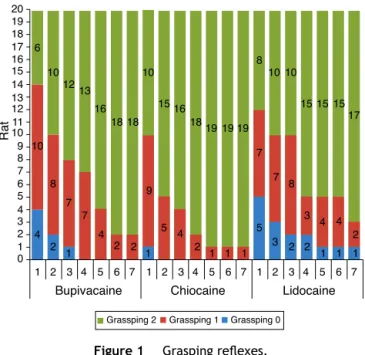RevBrasAnestesiol.2016;66(3):272---275
REVISTA
BRASILEIRA
DE
ANESTESIOLOGIA
PublicaçãoOficialdaSociedadeBrasileiradeAnestesiologia www.sba.com.brSCIENTIFIC
ARTICLE
Evaluation
of
sciatic
nerve
damage
following
intraneural
injection
of
bupivacaine,
levobupivacaine
and
lidocaine
in
rats
Oznur
Sen
a,∗,
Nevzat
Cem
Sayilgan
b,
Ayse
Cigdem
Tutuncu
b,
Mefkur
Bakan
c,
Guniz
Meyanci
Koksal
b,
Huseyin
Oz
daDepartmentofAnesthesiologyandReanimation,MinistryofHealth,HasekiTrainingandResearchHospital,Istanbul,Turkey bDepartmentofAnesthesiologyandReanimation,IstanbulUniversity,CerrahpasaMedicalFaculty,Istanbul,Turkey
cDepartmentofAnesthesiologyandReanimation,BezmialemVakifUniversity,FacultyofMedicine,Istanbul,Turkey dDepartmentofAnesthesiologyandReanimation,MedipolUniversity,FacultyofMedicine,Istanbul,Turkey
Received11September2014;accepted29September2014
Availableonline12March2015
KEYWORDS
Localanesthetics; Lidocaine; Bupivacaine; Levobupivacaine; Neurotoxicity
Abstract
Objective:Thelocalanestheticsmaycauseneurotoxicity.Weaimedtocomparetheneurotoxic potentialofdifferentlocalanesthetics,localanestheticinducednervedamageandpathological changesofaperipheralnerve.
Methods:SixtyWistarratsweighing200---350gwerestudied.Ratswereassignedinto3groups and26-gaugeneedlewasinsertedundermagnificationinto theleftsciaticnerveand0.2mL of0.5% bupivacaine,5% levobupivacaine, and2% lidocaine were injected intraneurally. An individualwhowasblindtothespecificsoftheinjectionmonitoredtheneurologicfunctionon postoperative1stday,anddailythereafter.Neurologicexaminationincludedassessmentfor thepresenceandseverityofnociceptionandgraspingreflexes.Atthe7thdaysciaticnerve specimenwastakenforevaluationofhistopathologicchanges.
Results:Therewasnostatisticaldifferencedetectedamonggroupsregardinggraspingreflex andhistopathologicevaluation.Twocasesinbupivacainegroup,1caseinlevobupivacainegroup and2casesinlidocainegrouphadslightgrasping,while1caseinlidocainegrouphadnograsping reflexontheseventhday.Severeaxonaldegenerationwasobservedinallgroups,respectively inbupivacainegroup4(20%),levobupivacainegroup3(15%),andlidocainegroup6(30%).
Conclusion:Inallgroups,histopathologicaldamagefrequencyandseverityweremorethanthe motordeficiency.
©2015SociedadeBrasileiradeAnestesiologia.PublishedbyElsevier EditoraLtda.Allrights reserved.
∗Correspondingauthor.
E-mail:senoznur@gmail.com(O.Sen).
http://dx.doi.org/10.1016/j.bjane.2014.09.012
Intraneuralinjectionofbupivacaine,levobupivacaineandlidocaine 273
PALAVRAS-CHAVE
Anestésicoslocais; Lidocaína; Bupivacaína; Levobupivacaína; Neurotoxicidade
Avaliac¸ãodalesãodonervociáticoapósinjec¸ãointraneuraldebupivacaína,
levobupivacaínaelidocaínaemratos
Resumo
Objetivo: Osanestésicoslocaispodem causarneurotoxicidade.Nossoobjetivo foicomparar opotencialneurotóxicodediferentesanestésicoslocais,osdanosinduzidosaosnervoseas alterac¸õespatológicasdeumnervoperiférico.
Métodos: SessentaratosWhistlerpesando200-350gforamestudados.Osratosforamdivididos em trêsgrupos,umaagulhadecalibre26foiinseridanonervociático esquerdo,comouso deampliac¸ão,e0,2mLdebupivacaínaa0,5%,levobupivacaínaa5%elidocaínaa2%foram injetados porviaintraneural. Umcolaborador, cego para osconteúdos dasinjec¸ões, moni-torouafunc¸ãoneurológicanoprimeirodiadepós-operatórioedepoisdiariamente.Oexame neurológico incluiuaavaliac¸ãodapresenc¸a edagravidadedanocicepc¸ãoedos reflexosde agarrar. Nosétimodia, umaamostradonervociático foicolhida paraavaliarasalterac¸ões histopatológicas.
Resultados: Nãohouvediferenc¸aestatísticaentreosgruposemrelac¸ãoaoreflexodeagarrareà avaliac¸ãohistopatológica.Doiscasosnogrupobupivacaína,umcasonogrupolevobupivacaína edoiscasosnogrupo lidocaínaapresentaramum levereflexodeagarrar;tambémnogrupo lidocaína,umcasonãoapresentoureflexodeagarrarnosétimodia.Degenerac¸ãoaxonalgrave foiobservadaemtodososgrupos:quatrocasosnogrupobupivacaína(20%),trêscasosnogrupo levobupivacaína3(15%)eseiscasosnogrupolidocaína(30%).
Conclusão:Emtodososgrupos,afrequênciadedanohistopatológicoedegravidadefoimaior queadeficiênciamotora.
©2015SociedadeBrasileira deAnestesiologia.PublicadoporElsevierEditoraLtda.Todosos direitosreservados.
Introduction
Effects of intraneural injection of local anesthetics and peripheral nerveinjury arerarecomplications of regional anesthesia. Most of these are temporary, subclinical mononeuropathies.1 Reversible axonal damage and injury
progressing to myelin degeneration can be determined histopathologicallyafterintraneuronalinjections.Inanimal studies, retention of motor functions despite the damage hasbeenobserved.2
Thisstudyhasaimedatinvestigationintheratofmotor dysfunctionandthehistopathologicalchangesafterasingle doseinjectionintraneurallyofbupivacaine,levobupivacaine andlidocaine.
Methods
Hospital Animal Ethics Council approval was obtained for thisstudy.SixtyWistarratsof200---350gweightwerekept inthelaboratoryunderconditionsof20---24◦Ctemperature, 65---70%humidity,12hlightand12hdarkwithunrestricted feed and liquid requirements. Experimentally, the rats wereanesthetized,afterfoodwithdrawalfor4h,by intra-peritoneal injection of 100mg/kg ketamine hydrochloride (Ketalar®, Eczacıbas¸ı Warner Lambert, ˙Istanbul, Turkey).
Subsequently,theglutealmuscleareawascleanedwith bat-ticonantisepticsolutionandthesciaticnervewasexposed throughalimitedtransverseincision.Intraneuralinjections were made with the use of an automatic infusion pump throughno26cannulaenteredat45---60◦ angles.
The ratsweresubdivided intothreegroups asGroup B (Bupivacaine)given0.2mL0.5%bupivacaine;GroupC (Chi-rocaine)given 0.2mL 0.5% levobupivacaine, and Group L (Lidocaine)given0.2mL2%lidocaineover1mininfusions. Theratswerewokenupafterclosingtheincisions.
Neurological functions of the rats were evaluated by threeindividuals,not informedof theapplied local anes-thetics, every day up to 7 days after the intraneural injections. For neurological assessment, nociception and thegrasping reflexwere evaluated. Nociception was trig-geredbypainonthefirstandthefifthphalangesandrated as 4/‘normal withdrawal reflex’, 3/‘slower withdrawal’; 2/‘slow withdrawal or sound; absence of movement’; 1/‘very slight withdrawal’; 0/‘no withdrawal’; and the grasping reflex was rated as 2/‘normal grasping reflex; 1/‘slowgrasping’;0/‘absenceofgrasping’.
The ratsweregivenketaminehydrochloride, sacrificed bydecapitationandthesciaticnervewasexcised.The sam-pleswereroutinely placedin10% bufferedformaldehyde, embedded in paraffin, dyed with haemotoxylin and eosin andexamined underlight microscopyfor integrity of the neurologicalstructure,mechanicaldamage,myelindamage andcellularinfiltration.
Myelin damage was estimated using the Nerve Injury ScoringSystem (NISS), andthescoring wasas1=‘normal, mild degeneration or demyelination’, 2=‘moderate level of degeneration’ or (<50% damaged nerve tissue) and 3=diffusedegenerationordemyelinization(>50%damaged nervetissue).
274 O.Senetal. 20 19 18 17 16 15 14 13 12 11 10 Rat 9 8 7 6 5 4 3 2 1 0 1
Bupivacaine Chiocaine Lidocaine
2 3
Grassping 2 Grassping 1 Grassping 0
4 5 6 7 1 2 3 4 5 6 7 1 2 3 4 5 6 7 4
2
1 1 1 1 1 1 1 1
5 3 3 8 8 10 10
15 15 15 17 7 7 2 2 2 4 4 8 7 7 4 2 9
19 19 19
5 4 2 2 10 6 10 12 13 16 18 18 10 15 16 18
Figure1 Graspingreflexes.
Thedamagescoreswereestimatedforeachofthe anesthet-icsusedwiththeone-wayANOVAtestandthevaluep<0.05 wastakentorepresentstatisticalsignificance.
Results
There was no statistically significant difference in the weightsof the3 groups of rats. Also,therewere no sta-tisticallysignificantdifferencesbetweenthegraspingreflex scoresofthethreegroups.
In the intragroup comparisons, however, there was a statisticallysignificantincrease inthegraspingreflexes of GroupB(p=0.003)andC(p=0.0081)onthethirddayand inGroupL(p=0.004)onthefourthdayafterinjectionsas comparedtothe first day (Fig.1). Results of nociception evaluationonresponsetopainonthefirstandthefifth pha-langeswereintactinallgroupsfromthefirstdayonwards. Histopathologicalratingof NISS asmild, moderateand severedamageinGroupB(35%,45%and,20%respectively), Group C (45%, 40% and 15% respectively) and in Group L (20%,50%and30%)didnotyieldstatisticallysignificant dif-ferencesbetweenthegroups(Fig.2).
Discussion
During regional anesthesia peripheral nerve damage is a rarely observed complication with the incidence varying between0.5%and1%intheretrospectivelyscannedstudies. Theseinjuriesaremostlyreversibleanddevelopas subcli-nicalormildmononeuropathies.Themechanismofdamage developingafter intraneuralinjections hasnotbeen com-pletelyunderstood.3Conventionallocalanestheticsarealso
neurotoxic.4---6This damageprobablyresultsfrom
mechan-ical trauma, the chemical and toxic effects of the local anesthetics,ischemiaoracombinationofthesefactors.
In ourstudy the response topain perception fromthe firsttotheseventhdayafterinjections wascompleteand itwasthesameinalltheexperimentalgroupssuchthatno differencescouldbeobserved.
20 19 18 17 16 15 14 13 12 11 10 9 8 7 6 5 4 3 2 1 0
Bupivacaine Chiocaine Lidocaine 7 9 4 3 8 9 4 10
Axonal degeneration and edema more than 50%
Edema and degeneration less than 50%
Minimal edema and normal nerve tissue
6
Figure2 HistopathologicalratingofNISS.
With respect to the grasping reflex, despite the lack of statistically significant intergroup differences, the sev-enthdaypost-injectionresultsshowedcontinuationofslow graspingin2ratsofGroupB,andin1ratofGroupC,while inGroupL,thereflexwasabsentin1ratandslowin2rats. Histopathologicalevaluationsshowedthat 4rats inGroup B,3ratsinGroupCand6ratsinGroupLdevelopedsevere axonaldegeneration.
Yamashita et al.4 investigated the neurological and
histopathological effects and the glutamate concentra-tion in the cerebrospinal fluid of 5 groups of rats one week after the injection of 0.3mL NaCl, 2% tetra-caine, 10% lidocaine, 2% bupivacaine and2% ropivacaine. Whereas the CSF glutamate concentrations had signifi-cantly increasedin all groups; there were nostatistically significant differencesin theneurologicalandmotor func-tions between the groups except the lidocaine group that showed significant dysfunction. Histopathological changes were characterized by the width of vacuolation in the dorsal funiculus and was in the respective order oflidocaine=tetracaine>bupivacaine>ropivacainegroups. Similarly,inourstudy,althoughstatisticallysignificant dif-ferences were not observed, the pronounced toxicity of lidocainewasevidentwithonerathavingtotallossofmotor functionwithtwoothersshowingmildloss.
HistopathologicalinvestigationbyYamashitaetal.4also
revealed that although the neuronal damage was equally advancedinthelidocaineandtetracaineinjectedrats,the neurologicalandmotorfunctiondeficit wasseverer inthe lidocaine group which suggests that the margin of safety withlidocaineisverynarrow.
Anotherconflicting observationin ourstudyis thatthe severityofhistopathologicaldamageandthelossofmotor functiondidnotprogressinparallel.Iohometal.7inastudy
Intraneuralinjectionofbupivacaine,levobupivacaineandlidocaine 275
histologicalobservationof neuronaldamagein 60%of the intraneurallyinjectedpigs. Similarly,in ourstudy,despite theobservationofmassiveaxonaldegenerationin4,3and 6ratsof,respectively,GroupsB,CandL,onlymildlossof motorfunction wasobserved in2,1and2 ratsof respec-tivelyGroupB,CandL,withtotallossoffunctionin1rat ofGroupL.
Raducan et al.9 aimed to characterize morphological
andfunctional aspectsof sciaticnerve regeneration after mechanicalcrushinjuryinrodents.Ratnervesampleswere collectedbeforeinjuryandafter24h,fourdays,twoweeks, and four weeks after injury. They found that morpho-logicmostevidentchangescausedbyaxonaldegeneration observedafterfourdayspost-injury.Afterfourweeks,the number anddensity of the regenerated myelinated axons werehighercomparedtocontrols. About themotor func-tion,theyfound that markeddecreaseonfunction in the first week followed by a gradual recovery of normal gait duringthefollowingweeks,sothatbytheendofthefourth weekanimal’sregainednormalgait.Raducan’sstudydiffers fromours withrespecttogeneration ofa crushinjury. In their study,massive axonal degeneration withmotor dys-function and their normalizations coincide. But ourstudy andothers,theneurotoxiceffectoflocalanestheticagents alsoarepresent.Ontheotherhand,weevaluatedthemotor functiontesttill7daysandtookhistopathologicspecimens on7thday.However,inthestudyperformedbyIohometal., evaluation was performed on the 67th day in which the motordysfunctionwasimprovedtotally,whereasthe mas-sivehistopathologicdamagecontinued.
According to our study, intraneural injection of local anesthetics may cause both histopathologic changes and motordeficiencyinvariousfrequencyandseverityinrats. Thehigherfrequencyandseverityofhistopathologic dam-agemorethanthatofmotordeficiencyarereasonable,but
histopathologicaldamageandthelossofmotorfunctionmay notprogressinparallel.
Conflicts
of
interest
Theauthorsdeclarenoconflictsofinterest.
References
1.LinguoryGA.Complicationsofregionalanesthesia:nerveinjury and peripheral neural blockade. J Neurosurg Anesthesiol. 2004;16:84---6.
2.BigeleisenPE.Nervepunctureandapparentintraneuralinjection duringultrasound-guidedaxillaryblockdoesnotinvariablyresult inneurologicinjury.Anesthesiology.2006;105:779---83.
3.Jeng CL. Intraneural injections and regional anesthesia: the knownandunknown.MinervaAnesthesiol.2011;77:54---8.
4.Yamashita A, Matsumato M, Matsumato S. A comparison of theneurotoxic effects on thespinal cord oftetracaine, lido-caine,bupivacaine,andropivacaineadministeredintrathecally inrabbits.AnesthAnalg.2003;97:512---9.
5.Epstein-BarashH,ShichorI,HwonAH.Prolongeddurationlocal anesthesia with minimal toxicity. Proc Natl Acad Sci U S A. 2009;106:7125---30.
6.MillerRD.Miller’sanesthesia.7thed.Philadelphia,PA:Churchill Livingston/Elsevier;2010.
7.IohomG,LanGB,DiarraDP.Long-termevaluationofmotor func-tionfollowingintraneuralinjectionofropivacaineusingwalking trackanalysisinrats.BrJAnaesth.2005;94:524---9.
8.LupuCM, Kiehl TR, ChanVW. Nerve expansion seen on ultra-soundpredicts histologicbutnotfunctionalnerveinjury after intraneural injection in pigs. Reg Anesth Pain Med. 2010;35: 132---9.
